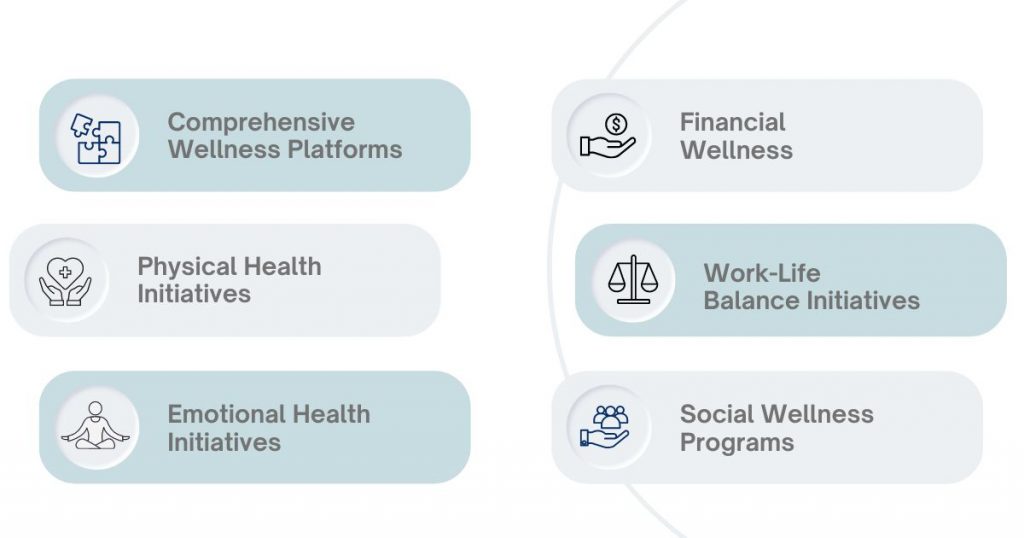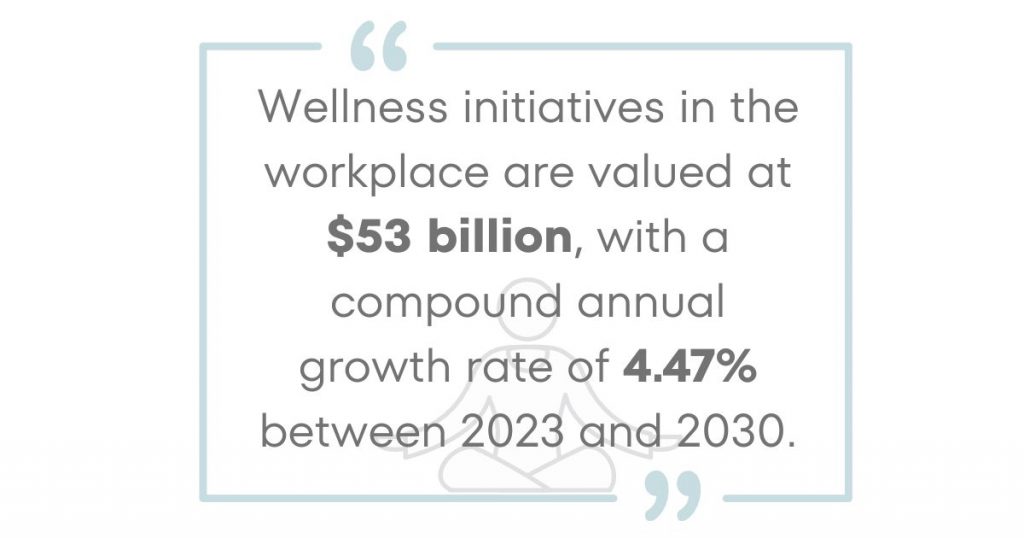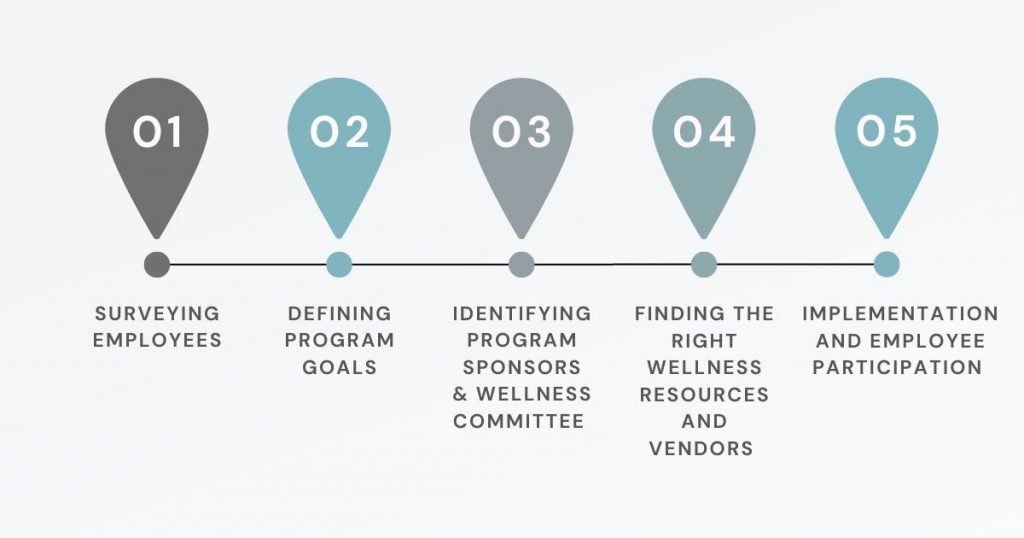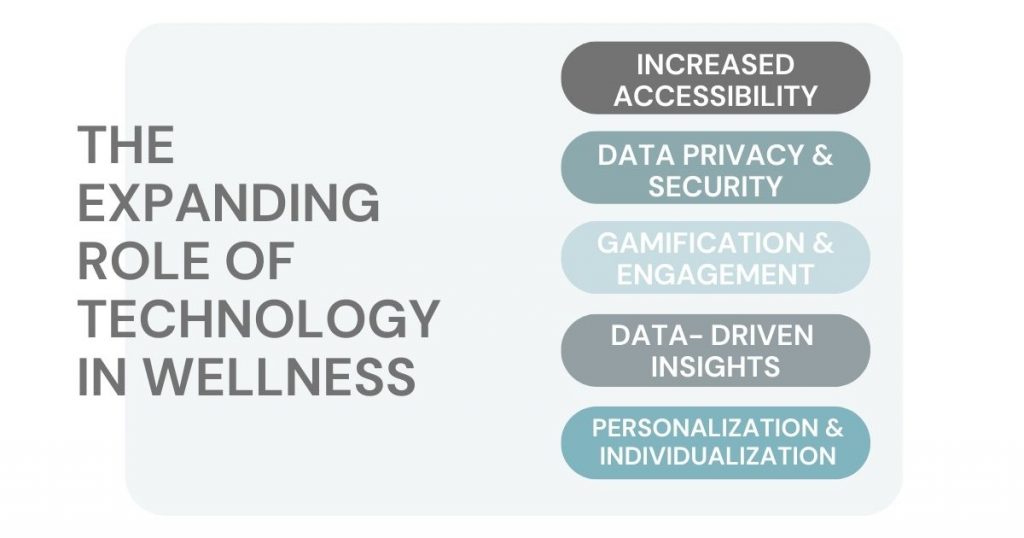
Bravo Alternative Providers in the Wellness Space
Bravo may be a comprehensive provider, but the following wellness alternatives introduce features, tools, and focus areas that address a broad spectrum of employee needs and employer objectives.

The Global Wellness Institute broadly defines wellness in the workplace as any activity or organizational policy designed to promote and improve employee health.
In the past few decades, traditional well-being initiatives primarily focused on physical fitness.
However, the evolving work landscape, fueled by technological growth, transformed how we perceive this concept today. We now recognize the consequences of workplace stress and burnout on a person’s well-being in and outside the workplace.
In times of decreasing employee engagement and record stress levels, there is an even greater need for a holistic approach to corporate wellness. This means going beyond physical health and considering multidimensional aspects of well-being, including mental, emotional, social, and financial.
Between the pursuit of healthier lifestyles and the expansion of technology, this Shortlister article addresses the multifaceted needs of employees, explores the evolving nature of wellness programs, and analyzes the role of digitalization in enhancing workplace well-being.

In today’s fast-paced workplace, wellness has become a buzzword often associated with a company’s success. Many studies explore its positive effect on employee turnover, satisfaction, performance, and overall health.
For example, research by Virgin Pulse reveals that 74% of companies with a holistic wellness program report higher employee satisfaction. Another study exploring wellness at work concludes that more than half of workers took fewer sick days, 67% lost weight, and 88% were more motivated to pay attention to their health.
However, excessive overworking or a poor work-life balance can hinder self-care, with the repercussions spilling into the workplace.
A poll by Go1 shows that almost a third of employees would quit their job if it didn’t allow a good work-life balance. Moreover, research reveals that overworking can lead to depression and anxiety, which can have an impact on physical health as well.
Considering the advantages and consequences, whether we look at this situation from an employee or an employer standpoint, it reveals a pressing need to revert the focus to well-being.
Prioritizing employee health yields numerous benefits both for individuals and the organization. Engaging in wellness initiatives can reduce absenteeism, improve satisfaction, foster positive company culture, and enhance employee engagement and loyalty.
Using technology plays a vital role in creating and sustaining these outcomes, as we can now develop innovative solutions for tracking, managing, and improving employee well-being. Hence, companies can provide wellness programs that cater to individual employee needs and preferences.
From comprehensive platforms to niche solutions, employers can choose a personalized wellness program that prioritizes employees’ needs and objectives rather than simply following trends.
Wellness at work has a long history that, despite a humble beginning, kept pace with workplace evolution. Some believe the first mention of employee well-being dates to the 17th century, when Italian physician Bernardini Ramazzini wrote about occupational diseases and possible preventative measures.
In 1817, social reformer Robert Marcus Owen proposed the 8-hour workday to help protect employee well-being.
Decades later, in 1879, Pullman Company, a railroad car manufacturer, created an employee athletic association, an early example of a wellness initiative. During this time, companies often made communities or “company towns,” where they provided housing, stores, or schools for their employees and their families.
While this was standard practice, the athletic association went a step further in accommodating employees’ needs.
The “modern era” of employee wellness started evolving in the 1970s. Since then, the growth of technology coupled with an awareness of unique employee needs and challenges has led to many wellness options with a holistic approach to health.
Nowadays, most employers offer some type of employee wellness program, and the following examples showcase how organizations utilize them to benefit their workforce.

Holistic wellness programs go beyond addressing singular aspects of employee well-being. Instead, they integrate various elements into a cohesive approach.
These programs often include health assessments, personalized goal setting, fitness challenges, mental health resources, nutrition guidance, financial coaching, and even Employee Assistance Programs (EAPs) for additional support.
For example, Google’s comprehensive approach to wellness incorporates anything from access to fitness centers and massages on-site to mental health apps and support groups. The company also has a platform where it promotes digital well-being.



Physical health initiatives focus on fitness, nutrition, sleep, and preventing and managing illnesses, injuries, or chronic conditions.
From workout challenges to healthy snacks, there are many ways to facilitate physical wellness in the workplace. Another example is enabling access to health apps or wearable devices. This approach encourages employees to use these devices and health apps to track their activity and overall well-being.
An excellent illustration of leveraging technology in workplace wellness is the collaboration between Virgin Pulse and Fitbit. It allows employees to sync their Fitbit trackers with a wellness platform, participate in step challenges, and earn rewards for reaching activity goals.
Creating a supportive and stigma-free environment where employees can access mental health resources and seek professional help is crucial. As part of that, employers can offer digital platforms and applications, including mindfulness programs, meditation exercises, and cognitive-behavioral therapy tools.
For instance, Unilever, a consumer goods company recognized for brands like Dove and Ben & Jerry’s, has implemented various initiatives to create a supportive environment and address mental health challenges.
Notably, the company has trained 4,000 global employees to support their colleagues by recognizing signs of mental health struggles and connecting them with appropriate services and resources.
Furthermore, Unilever stands out as one of the founding partners of the Global Business Collaboration (GBC) for Better Workplace Mental Health, an initiative led by businesses to advocate for and expedite positive change regarding mental health in the workplace.
Statistics show that for 46% of workers, finances are the most significant stressor, costing employers up to $1,900 per employee per year. However, more concerning findings also show that one in three Americans is not financially literate.
To minimize the repercussions and reduce stress, companies like Protiviti, a global consulting firm, offer financial wellness programs to assist workers in managing their finances effectively. This may include financial education seminars, budgeting tools, or access to financial advisors.
Work-life balance is crucial for overall employee wellness. Employers can leverage technology to implement flexible work arrangements, telecommuting options, or policies encouraging employees to take breaks and disconnect from work. This helps the workforce balance their personal and professional lives, reducing stress and enhancing well-being.
Finally, the workforce’s multifaceted needs should also address workplace loneliness and isolation among employees.
Social wellness initiatives are of utmost importance, as they foster a sense of belonging, connection, and positive relationships within the organization. They promote a supportive and inclusive work culture through various activities such as team-building exercises, social events, mentorship programs, employee resource groups, and collaborative projects.
The Society for Human Resource Management (SHRM) reports that in 2019, 58% of employers offered some form of wellness benefit. Another recent survey, 2022 Global Benefits Attitudes, reveals that up to 69% of companies prioritize well-being support to improve their benefits.
While different studies and surveys may show somewhat different engagement, there is a growing trend of wellness initiatives in the workplace. In fact, predictions for the global market size, valued at $53 billion, show an expansion with a compound annual growth rate (CAGR) of 4.47% between 2023 and 2030.

As awareness rises, so will the corporate wellness market.
The growth and promotion of wellness programs in the workplace we’re experiencing relies heavily on the expansion of technology. In the past, organizations relied heavily on manual processes and limited resources to implement wellness programs.
Today, digital solutions simplify and streamline these efforts, making it easier for employers to create a culture of well-being. While it does help immensely, finding out how to promote wellness in the workplace is still a complex issue since there isn’t a one-size-fits-all approach.
Employers need a well-thought-out strategy that focuses explicitly on their organizational challenges. Usually, this includes an employee-centric approach that focuses on understanding their needs and offering tailored solutions.
However, for any initiative to work, the support and involvement of leadership is paramount.
The best leaders are those who lead by example. Therefore, when they prioritize employee well-being, it sets a positive tone for the entire organization. From actively participating in wellness initiatives to offering incentives, leaders can increase awareness about well-being, thus encouraging participation.
Many employees might not fully understand or appreciate the advantages of participating in such initiatives, and without their participation, the success of the initiatives will be little to non-existent.
Therefore, the key is to listen and note what they want before implementing a wellness program that complements the workplace culture.
Research shows that while 80% of companies claim to support their workforce’s physical and emotional well-being, only 46% of employees feel supported. The disconnect often lies in a poorly executed process and failure to meet the workforce’s needs.
Thus, to successfully implement wellness programs in the workplace, employers should consider factors such as employee opinions, program goals, wellness vendors, and evaluations while utilizing technology to enhance these initiatives.

The clash of opinions, priorities, and needs in the workplace makes every wellness initiative unique. Therefore, understanding the preferences of employees should be the starting point.
Surveying employees and creating focus groups can quickly assemble feedback on the areas of wellness that employees value the most. This imposes asking questions about their current health habits, interests, and specific wellness areas they would like to focus on.
The information should serve as a foundation for designing a program that resonates with the specific needs of all employees.
After gathering data, the next step is to analyze the survey results and identify common themes or areas for improvement. The feedback should define specific program goals that align with workers’ needs and interests.
For instance, if mental health emerges as a priority, the program could focus on implementing stress management initiatives, offering mental health resources, or introducing mindfulness practices. Digital tools, like mental health apps or online well-being platforms, can complement these goals.
The next step would be to assign individuals within the organization responsibilities to oversee and support program implementation. Often referred to as sponsors, they typically hold a leadership or influential position and are crucial in driving the wellness program’s success.
Moreover, forming a wellness committee of representatives from various departments will ensure diverse perspectives and effective program management. They can help plan, implement, and evaluate the wellness program while acting as advocates and role models.
Employee wellness statistics suggest that 49% of employers would use a third-party vendor to implement a wellness program in the workplace.
Deciding on wellness resources and vendors largely depends on the program goals. Therefore, they must align with the employees’ preferences and real needs. This could include anything from fitness trackers and wellness apps to online training platforms and access to financial advisors.
Taking the final steps include a gradual introduction to a wellness program. A progressive implementation will allow for proper onboarding and adjustment, encouraging employees to participate.
The first stage would convey the program’s purpose, goals, and available resources to employees. Then, through regular communication and incentives, companies can initiate participation.
It’s also essential to provide educational materials, host wellness challenges, and organize workshops or webinars related to various aspects of well-being.
Keep in mind that creating healthy habits extends beyond a one-time initiative. Therefore, it’s vital to measure feedback and results to pinpoint what works and what can be improved so that the program reaches maximum effectiveness.
Many companies have embraced the challenge of promoting wellness in the workplace and have achieved remarkable success in doing so. By implementing innovative practices and leveraging technology, these organizations have transformed their work cultures and increased their bottom line.
A Forbes-published case study on the positive impact of investing in employee well-being helps us better understand the essence of wellness programs in the workplace. It explores how SAP, a multinational software company, achieved measurable results through wellness.
Namely, by treating it as a core business strategy, the business attained a significant ROI through higher engagement, lower turnover, and improved productivity. Another notable aspect is that the company’s commitment to employee well-being had exceptional leadership support, with the Co-CEOs and board leadership making it a strategic priority linked to its bottom-line profits.
The comprehensive health approach includes on-site medical and psychological services, emergency management, and health training. SAP supports parents with daycare programs and on-site childcare facilities and offers flexible work hours and programs to reduce employee stress and enhance work-life balance.
Mental health is also prioritized, with campaigns to raise awareness, workshops on mindfulness and emotional intelligence, and access to mental health support services.
SAP’s success highlights the significance of a strategic and systematic approach to employee well-being, and it’s not the only example.
First South Financial joined the CDC’s National Healthy Worksite Program to enhance its wellness initiatives. With support from management, they conducted assessments, set goals, and implemented evidence-based strategies. Ultimately, the program improved employee health and increased physical activity.
Moreover, this led to better control of high blood pressure. Employees showed support for the program and reported positive effects on their health. The program positively impacted employee well-being and created a supportive work environment.
From improved employee engagement and retention to increased productivity and better control of health conditions, the positive impact of wellness initiatives cannot be overstated. The numerous case studies and an increasing interest in employee health are evidence enough that they can benefit the workplace.
By recognizing wellness as a core business strategy and providing the necessary resources and support, companies can unlock the full potential of their workforce and help their employees lead better, healthier lives.
Before we wrap up this article, let’s look closely at technology and how it has transformed how we approach wellness in the workplace.
What we already mentioned, from the types of programs to their implementation, wouldn’t be as effective and straightforward without the massive expansion of technology in HR and wellness.
Market predictions and the expected CAGR suggest further expansion of wellness, and chances are technology will have a significant role in this.
Right now, its impact is mainly seen in aspects such as:

Embracing wellness in the workplace goes beyond being a strategic move—it’s an ethical obligation that can revolutionize every facet of a business.
In this era of digital transformation, technology has emerged as a powerful catalyst, amplifying the reach and impact of employee wellness programs in the workplace.
While we can’t predict the full extent of technological advancements, it will likely continue to drive the promotion and enhancement of employee benefits, taking workplace wellness to new heights.
Disclosure: Some of the products featured in this blog post may come from our partners who compensate us. This might influence the selection of products we feature and their placement and presentation on the page. However, it does not impact our evaluations; our opinions are our own. The information provided in this post is for general informational purposes only.
Content Writer at Shortlister
Browse our curated list of vendors to find the best solution for your needs.
Subscribe to our newsletter for the latest trends, expert tips, and workplace insights!

Bravo may be a comprehensive provider, but the following wellness alternatives introduce features, tools, and focus areas that address a broad spectrum of employee needs and employer objectives.

As sleep deprivation significantly affects work performance, is the tradeoff between employees working long hours or being available 24/7 worth it?

From benefits types to designing personalized packages, discover how a strategic approach to benefits can favor both the personnel and the employers.

Optimize your benefits administration by uncovering the keys to evaluating and selecting the ideal solution for your organization’s evolving needs and priorities.
Used by most of the top employee benefits consultants in the US, Shortlister is where you can find, research and select HR and benefits vendors for your clients.
Shortlister helps you reach your ideal prospects. Claim your free account to control your message and receive employer, consultant and health plan leads.